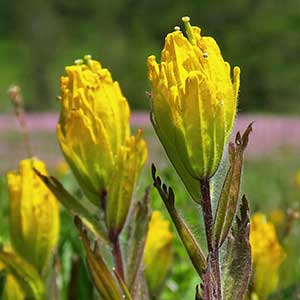Castilleja levisecta
Castilleja campestris
golden Indian paintbrush, golden paintbrush
field owl's-clover, meadow paintbrush, vernal pool Indian paintbrush, yellow owl's clover
few to many, erect, ± decumbent or creeping at base, unbranched, sometimes branched, hairs spreading, medium length and long, soft, mixed with short stipitate-glandular ones.
solitary or few, erect, unbranched, sometimes branched, glabrous or hairs sparse proximally, spreading, long, soft distally.
green to purple or brown-tinged, linear-lanceolate proximally, oblong-ovate or -obovate distally, 0.8–5.2 cm, not fleshy, margins plane, distalmost sometimes ± wavy, involute, 3–7(–11)-lobed, apex obtuse;
lobes erect to ascending, linear to linear-spatulate, very short, toothlike, usually arising from distal 1/3 of blade, apex rounded.
green, sometimes purple-tinged, linear to narrowly lanceolate, (0.4–)1–4 cm, not fleshy, thin and flexible or thick and ± brittle, margins plane, involute, 0-lobed, apex acuminate.
2.5–25 × 1–4 cm;
bracts bright yellow throughout, or proximally greenish, distally bright yellow, sometimes deep yellow-orange, especially with age, oblong, elliptic, or obtuse to ovate, (0–)5–9(–13)-lobed, sometimes wavy-margined;
lobes erect to ascending, oblong, short to medium length, arising above mid length, central lobe apex rounded, lateral ones rounded to acute.
2–15 × 2–3 cm;
bracts green throughout, sometimes purplish tinged, linear to narrowly lanceolate, 0-lobed, apex acute.
straight or slightly curved, 17–28 mm;
tube 12–15 mm;
beak exserted, adaxially green or greenish yellow, 6–8 mm;
abaxial lip yellow or greenish, reduced, not inflated, 2–3 mm, 25–33(–50)% as long as beak;
teeth ascending to erect, yellow, 0.5–1.5 mm.
straight, 11–26 mm;
tube 10–22 mm;
abaxial lip, beak, and part of tube exserted from calyx;
beak adaxially white or yellow, 3–6 mm;
abaxial lip yellow, sometimes orange, paler near teeth, prominent, deeply saccate with 3 lobes at ca. 90° from one another, pouches 6–10 mm wide, 3–4 mm deep, abruptly widening from tube, sacs ± round or ± rounded-triangular from above, villous within at base of teeth, 4–5 mm (2–4 mm from sinus), 70–90% as long as beak, puberulent;
teeth erect, white, sometimes with deeply colored bases, 0.5–2 mm.
distally yellow, 13–22 mm;
abaxial and adaxial clefts 4–9.5 mm, 30–40% of calyx length, deeper than laterals, lateral 2.5–4.5 mm, ca. 25% of calyx length;
lobes linear to narrowly oblong or narrowly lanceolate, apex obtuse, sometimes rounded to acute.
proximally green, pale, or purplish, distally purple or green, 5.5–11 mm;
abaxial and adaxial clefts 2–5 mm, 30–50% of calyx length, deeper than laterals, lateral 1.5–2.5 mm, 25–30% of calyx length;
lobes linear-lanceolate to narrowly triangular, apex acute to acuminate.
= 24.
= 24.
Castilleja levisecta
Castilleja campestris
Castilleja levisecta is listed as threatened in the United States and endangered in Canada, where it is extremely rare. Most of its grassland habitat has been altered by development in the Puget Trough, and there are historical stations in the metro areas of what are now Victoria, Portland, and Seattle. For several decades, C. levisecta was considered extirpated from Oregon. However, recent reintroduction programs in Oregon and Washington have been very successful at reestablishing this species at several sites in the Willamette Valley. The bright yellow inflorescences often gradually age to a golden yellow color, unique in the genus.
Castilleja levisecta is in the Center for Plant Conservation’s National Collection of Endangered Plants.
(Discussion copyrighted by Flora of North America; reprinted with permission.)
Varieties 2 (2 in the flora).
Castilleja campestris is sometimes confused with Triphysaria eriantha subsp. eriantha, but C. campestris has two-celled anthers and entire leaves, while T. eriantha has one pollen sac per stamen and strongly divided leaves.
(Discussion copyrighted by Flora of North America; reprinted with permission.)
1. Leaves and bracts linear; leaves thin, flexible; bracts shorter than or ± equal to flowers; corollas light to bright yellow; proximal pollen sacs to 1/3 length of distal. | var. campestris |
1. Leaves and bracts lanceolate; leaves thick, ± brittle; bracts longer than flowers; corollas usually yellow to orange; proximal pollen sacs ca. 1/2 length of distal. | var. succulenta |


